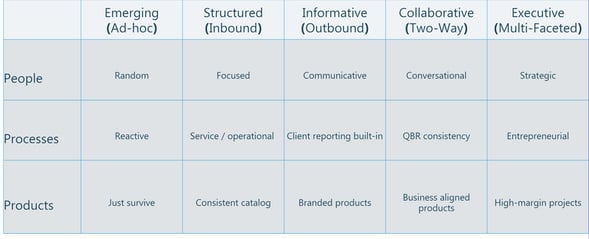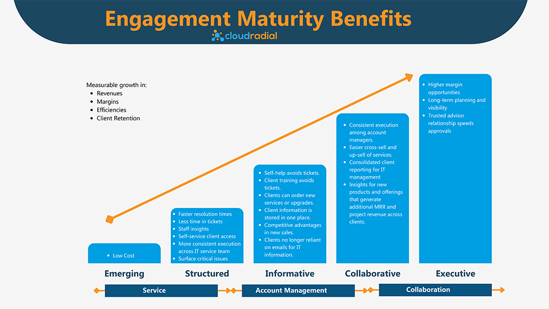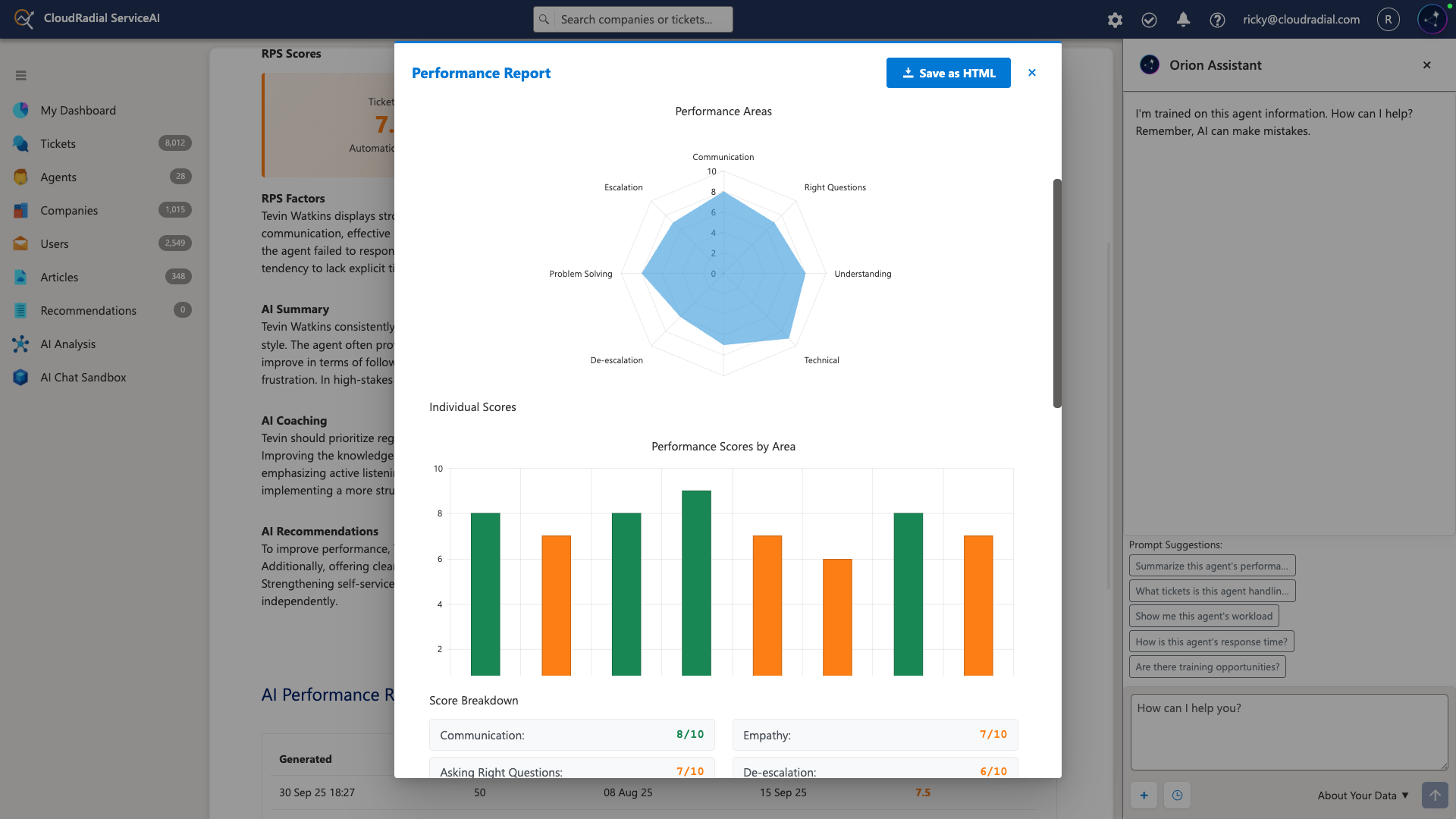Stop Measuring Productivity: Why AI Transformation Requires Different Metrics
Your service desk manager pulls up the dashboard and smiles. Response times are faster. More tickets handled per technician. Documentation time...
Get everything you need for the ultimate client experience
Enterprise-grade infrastructure with the flexibility MSPs demand
Perfectly tailored AI that knows your specific MSP

Build your own Shopify-like store with your PSA products & distributors
Have clients to submit tickets directly to your PSA, freeing up your team's time
Pre-triage and route tickets correctly with the help of AI
Deliver instant, accurate answers that can help achieve zero-touch resolution
You'll learn things like how to add revenue without adding cost, MSP best practices, and how to master client management.

CloudRadial, the provider of a Client Services Automation (CSA) platform for MSPs and IT Service Departments, has created a client engagement maturity model that works for Managed Service Providers and other IT service providers alike. This model measures the quality and efficiency of the relationships that MSPs have established with their client base and assigns one of five levels based on that measurement. The model helps MSPs maximize client opportunities. MSPs with higher engagement better anticipate their client's needs, ensure that their technology supports each client's business goals, and execute consistently. This model is called the IT Engagement Maturity Level™ (EML). It outlines the ways that MSPs can grow their business based on client relationships, and engagement and is facilitated by a Client Services Automation platform. Like the Operations Maturity Level pioneered by Service Leadership provides insight into an MSPs service-facing operations, EML provides insights into an MSP's client-facing effectiveness.
If you own or manage an MSP, you rely on a particular software stack, with processes and tools that can be exchanged for ones that better fit your client's needs at any time. Most MSPs have tools that help manage the operations side of the business, few consider how important it is to complement those tools with software that manages the client-facing side of managing an MSP. It’s like a traditional yin-yang symbol: if a PSA were the yin, the CSA platform is the yang. MSPs who have both can then focus on the operations and the client-facing aspects. The CSA puts the MSP on a path to developing client engagement.

EML is a framework of information that you can use to gauge your company’s real-time engagement maturity with your clients. Engagement maturity refers to how evolved client relationships are. When you consider what your relationship with your clients is like, what stands out? What’s important about the way you interact with them? How do they know what you’re bringing to the table? Can they count on you for managed IT services? How do they know that? Where do you see this relationship moving in the future? Are these relationships important to you and your business?
The Engagement Maturity Level maps out what MSPs can do to improve their client relationships. You can get away from saying to your clients, “these are the tools we have, use them to fix your problems”. Instead, you can change the approach to, “we understand your pain points, and we have the expertise to fix them.” Coming from a client-centered approach means understanding your client's specific concerns and having what they need to address them. Making client engagement a part of your business plan helps you increase MSP productivity and grow in ways that are helpful to your clients’ growth, too. An engaged MSP is a valuable partner to their clients. This is discussed in a guest article published by LogicMonitor on building stickier client relationships. Matt Harding discusses the five things that he loved when MSPs got them right:
Clearly, from the client’s perspective, that relationship depends on a lot of transparency, quick reaction times, and excellent communication, driving home that the MSP had the best interests of their client in mind.
EML provides a concrete plan for improved client relationships that leads to business growth. The basic structure of EML has five levels of improving engagement:
These levels are understandable across the way your team, processes, and products relate to your clients. Progressing levels improve engagement and ultimately can deliver the strategic relationships needed to deliver the best results for clients.

The table above is a simplified way to consider EML and how it applies to your business. Each of these levels is set apart by a specific shift in the way that an MSP manages client engagement, from Emerging MSPs who are just starting out beginning with a random set of clients, processes that are reactive and chaotic, and simply trying to engage and sign up as many clients as possible, all the way to the Strategic level. Here, clients are approached strategically, processes are highly defined, structured and consistent, and the products align around client needs across multiple levels of technology requirements.
Another notable benefit of client engagement maturity is that transparency between MSP and client grows and expands. While an MSP is in the Emerging stage, its processes are still random and chaotic. The MSP is getting the tasks done but struggles to demonstrate its value and often lacks organization to show a client how things are going. This creates gaps in trust leaving clients to ask “Is my MSP doing what they promised?”
By the time an MSP reaches the Strategic level, transparency between MSP and client is mutual. This relationship takes time to build and there is a big difference in how MSP and client work together. Information shared becomes insights that improve decision-making. MSPs at the Strategic level have visibility to do long-term planning with the client and are viewed as trusted advisors which helps speed up the approval process on the client side. A more mature client relationship also translates into greater benefits for the MSP. For example, the MSP can take a client conversation and turn it into insights to develop new offerings that generate additional revenue across clients. When the chaos is eliminated, transparency starts to add value. Greater transparency between clients and MSPs improves trust and engagement.
Transparency is a highly valued commodity in business, especially for MSPs and IT service groups. As LogicMonitor states in their Business Partner Code of Conduct, “We value honesty and transparency.” MSP Alliance, in Safe Managed Service Transparency and Accountability, explains the need for transparency and accountability with government contracts, clients, and the general public.
Each EML level also corresponds to specific behaviors regarding client activity. In Level 1, the Emerging level, applied to MSPs who are just getting started, is all about attracting as many clients as possible. Processes are just beginning to emerge, communication is generally unstructured and occurs via phone or email, and issues are resolved one client at a time. At the Emerging Level, it is challenging for an MSP to effectively service a client with onboarding and offboarding employees. For clients, these events can be planned or unplanned. When MSPs lack structure and organization, they must react to these requests, which creates chaos internally and puts client satisfaction at risk.
EML also aligns organically with a business’s operational maturity level or OML. This level corresponds to the Operational Maturity Level of 1, “ad hoc”: highly reactive, engaging as many clients as possible, and starting to build those relationships. OML 1 is also earmarked by chaos. Strengthening and improving both operations and client relationships helps to balance an MSP’s journey from 1 to 5 on the OML scale and Emerging to Strategic on the EML scale.
Moving into the 2nd level of EML, however, starts to yield significant changes. At the Structured level, an MSP has made changes to its processes and protocols. Chaos begins to look more like order and reactive responses to client requests diminish. Starting at or building up to the Structured level is built on the fact that MSPs are getting the hang of things within their business. MSPs are also starting to implement a structure for their MSP software, both on the operations side and in client relationships. These MSPs and IT service providers otherwise are considering or starting to invest in automation. Processes are starting to become services with operational elements and hierarchies. They offer a consistent catalog, and their responses are focused. This reduces the time spent in routine client interactions. It also helps to improve efficiency and scalability. Clients at this EML Level also correspond to OML 2: the Awareness level. This is where they are project-focused, have a basic organizational structure, and are learning to establish priorities.
Even larger changes are in store by progressing to EML level 3, Informative. At the Informative level, one of the hallmarks is a business that is all about trust and, therefore, highly communicative. It involves MSPs and their clients coming to the table about their concerns with an evidence-based approach, an indicator that they have all the same facts and need to communicate about how to proceed together. It also manages built-in client reporting (often through its PSA) and creates branded products. This level is an expansive one that involves the MSP becoming a brand. At the Informative level, the company is starting to become fiscally stable and somewhat profitable. Financials, however, are only one element of measuring business health. Some of the key benefits are continuing to reduce time and improve scalability in client reporting, and self-service in operations. At this level, MSPs begin to understand that they owe it to clients to prioritize transparency, especially around accountability and operations. Communications at this level are proactive. MSPs at this level are starting to focus more on what they can do to engender client loyalty and give back to their clients. This level corresponds with OML 3, Repeatable, in which processes are championed to make communications easier. Also, MSPs have standardized the overall product delivery experience.
At the Collaborative level, in EML 4, MSPs interact with their clients in ways that are conversational and collaborative. Trust has been built around a common set of facts, and true conversations happen here. MSP tools, processes and standardizations have, at this point, become the norm, and not having to spend time managing data means you have more time to improve your client service. This leads to the greater coordination of efforts and is more reliant on client feedback and discussion. This information is then used to map out the direction the business will take in the future. All clients, at this level, are provided basic insights and guidance. Clients are beginning to be viewed as considerable assets at the Collaborative level, more so than any other level before, and on par with operations. As such, the corresponding OML is 4, characterized by business and customer outcome focus. OML 4 also involves considerable collaboration. This occurs by examining the client life cycle, maintaining an emphasis on client success, and involving predictable client service -and MSP tool- delivery.
Strategic Engagement Maturity is marked by mutual trust between MSP and client, where both parties participate in building efficiencies for how they work together. EML 5 corresponds with OML 5, “Predictable”, to offer the highest level of client engagement and operational maturity. At this level, in Operational Maturity, the connection between business outcomes and client success is fully realized.
Strategic EML goes beyond Operational Maturity to parallel these strategies related to client engagement. This level is marked by collaborative trust and information turning into insights. These insights better inform the building of efficiencies for both the Managed Service Provider and its clients. At the Strategic level, MSPs are at the table, working with the client and anticipating their needs. Teams across these MSPs are engaged in client success and work to develop and offer services that are aligned and can scale as their clients grow.
The transformation from Emerging to Strategic on the IT Client Engagement Maturity scale is different for every MSP. What is consistent is that at every stage there are tangible benefits that encourage the MSP to keep evolving their client relationship. Client engagement is becoming increasingly more important as MSP work has migrated to the cloud and is now based more on intellectual property than labor.
Every business is built around two constants: operations and clients. This boils down to what you do, and whom you do it for. You must have something to offer your clients, and you have to have clients invest in your operations. Running your business requires a balance between taking care of operations on the one hand and your clients on the other. A PSA is a reliable tool for managing the operations of your business and increasing MSP productivity: from ticketing to scalability to cybersecurity.
Now more than ever, it’s imperative to consider the client engagement side of the equation. Thus far, clients have built their relationships with MSPs on trust that their pricing is fair, and their software will do what they’re supposed to. With everything in the cloud and clients being brought on board more and more by remote operations, it’s not enough anymore to tell a client, “Trust us, we’re doing everything right.” Clients expect greater accountability, and higher levels of trust come from that accountability, in addition to transparency, not from a simple handshake agreement.
Using CloudRadial’s CSA, MSPs can attend to the concerns of their clients in a way that is efficient, cohesive, and modern. It’s also a tool that provides a platform in sync with the PSA. MSPs and IT Service departments succeed and grow only when they have the right tools to do so.
Most MSPs believe that all they need is a PSA and don't realize the challenges they create for themselves and their users when they don't have a platform that addresses client engagement. After the PSA, a Client Services Automation (CSA) platform is the most important platform any MSP or IT Service Department should have. It’s the platform they will use to build and grow their client relationships. CloudRadial’s Client Services Automation (CSA) platform transforms the way MSPs, and IT teams engage, collaborate, and advise their clients and end-users. It consolidates all the IT touch points of ticketing, reporting, training, planning, and account management into a shared portal where clients and IT collaborate to resolve problems, understand issues, add new services, and plan future opportunities.
CloudRadial has shown that improving the EML of MSPs and IT Service Departments alike by deploying its one-of-a-kind Client Services Automation, works to advance these businesses’ growth. Deploying CloudRadial’s CSA not only helps to increase your clients’ experience as a business partner, but it helps to strengthen your Operational Maturity, too. And it couldn’t be simpler: a platform, accessible on a single pane of glass, that works with your existing PSA to improve your client engagement. Mostly, however, using CloudRadial’s CSA in tandem with your established PSA gives you all the information you need to regularly measure your EML. These insights can also be used to develop a plan to use client engagement maturity to grow to the next EML level, ensuring that your business is constantly improving and consistently providing your clients with the best overall service. When your clients know that they are in a partnership with you, they’re more interested in collaboration and transparency. EML will get you there.
Mostly, however, using CloudRadial’s CSA in tandem with your established PSA gives you all the information you need to regularly measure your EML. These insights can also be used to develop a plan to use client engagement maturity to grow to the next EML level, ensuring that your business is constantly improving and consistently providing your clients with the best overall service. When your clients know that they are in a partnership with you, they’re more interested in collaboration and transparency. EML will get you there.

Your service desk manager pulls up the dashboard and smiles. Response times are faster. More tickets handled per technician. Documentation time...

The Service Desk Crisis: Beyond the Surface Problems The average MSP service desk faces ticket volumes that have increased 40% over the past two...

The Current State of AI-Powered Service Delivery for MSPs The managed services industry is at an inflection point. Client expectations are rising,...